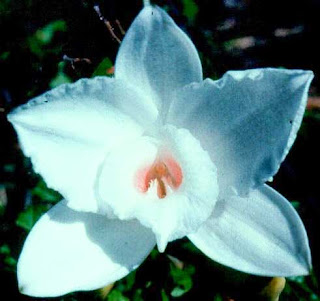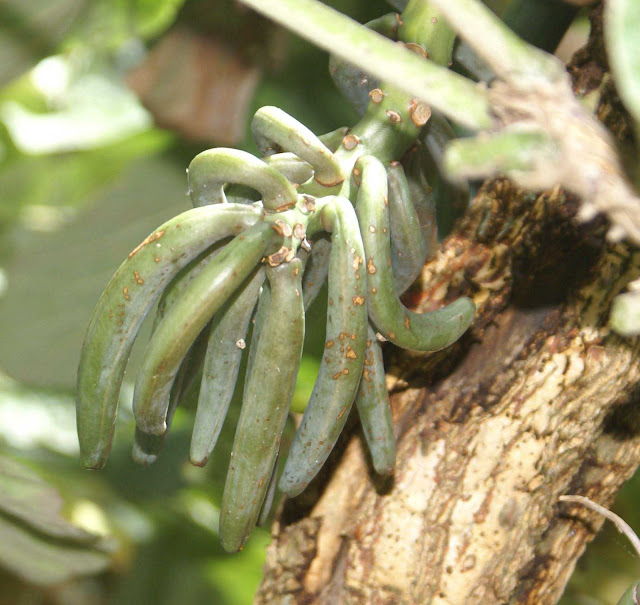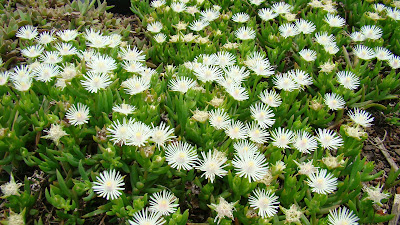In 2013 I first began noticing what was
very clearly herbicide damage and death being caused in particular to two
species of tree being Grewia occidentalis and Trema orientalis. I took photos
of the affected trees but could not establish the source of or the herbicide
that had caused the damage.
 |
| Trema orientalis that has been damaged by a very small dose of the herbicide picloram and is about to die. This tree has died since the photo was taken |
More and more I began noticing trees that
had been affected or had been killed by what was very clearly as the result of herbicide
poisoning but again I could not establish what herbicide had caused the death
of the trees and when the spraying had occurred, in some areas the last spraying
had occurred a few years previously.
About a year after first observing the herbicide
damage to trees and other plants I accidentally discovered the culprit
herbicide.
I had removed a narrow band of bark down to
the cambium on three trees on my property and carefully applied a very narrow
band of Kaput Gel containing Triclopyr and Picloram in a band of about 50 mm on
the bottom half of the area where the bark had been removed. Within a few days
I noticed that two trees growing within a meters of one of the trees started to
show signs of herbicide poisoning and within two weeks one of the small trees
Hippobromus pauciflorus was completely dead, the second small tree affected was
Obetia tenax which very nearly died but eventually after more than two years recovered.
For up to three meters along the line of the main roots all dicotyledonous
ground cover plants were affected. A wild grape Rhoicissus tomentosa growing
about six meters from one of the other trees was also very badly affected
clearly from herbicide leached from the tree that had been treated with Kaput
gel, eventually over ninety percent of the very large vine died what is left at
the time of writing being August 2017 has not completely recovered.
 |
| Obetia tenax two years after having been poisoned by picloram which leached from the roots of a tree that was ring barked and was treated with a herbicide gel some distance away |
Once that I had noticed how very small doses
of picloram had affected other plants growing nearby I investigated what
herbicides had been sprayed in the areas where so much herbicide damage had
occurred and discovered Plenum containing Picloram has been sprayed to control
weeds in adjoining grassland. In most areas where Plenum containing Picloram
had been sprayed 100% of Trema orientalis trees had died.
 |
| Trema orientalis that has been killed by a very small amount of the herbicide picloram,note that the two trees growing beneath it have not been affected |
Since then I have kept a very close eye on
where ever I have seen contractors spraying or applying herbicides. Time and
again I have found that Herbicides containing Picloram have caused excessive
amounts of damage and death to a number of species.
I have observed that the following trees as
extremely sensitive to very low doses of picloram
Barringtonia racemosa
Brachyleana discolor
Celtis africanus
Dombeya cymosum
Ficus lutea
Grewia occidentalis
Hippobromus pauciflorus commonly known as
false horsewood
Obetia tenax
Scadoxus puniceus
Trema orientalis
Wild grape Rhoicissus tomentosa
 |
| Croton sylvaticus dying after picloram that had been sprayed a year or two before was washed down to the root zone following heavy rains |
Research on the internet confirmed what I
had recorded but also brought to light some alarming facts as to the danger of
using Picloram in sensitive natural areas or near to them.
As a result of my own observations as well
as what information I have obtained from the internet and a number of experts
that I have discussed the danger of
applying Picloram with I will certainly never spray with any Herbicide
containing Picloram in any natural area neither would I recommend any one else
to do so.
I would go as far as to say do not under
any circumstances ever spray with any herbicide containing Picloram in
environmentally sensitive areas for instance in conservation areas or any other
area when no damage to indigenous vegetation may occur. Also do not use
herbicide gels containing Picloram and if there is absolutely no alternative
then do so with extreme caution and only on plants that cannot be controlled
with other herbicides because as reported above picloram leaches from the roots
from the roots of plants that have been treated with it killing or damaging desirable
plants growing nearby.
 |
| Damage has been caused to a Barringtonia racemosa a protected tree in South Africa at the uMdloti river lagoon by an NGO doing alien plant removal |
 |
| Barringtonia racemosa a protected tree has been killed by the uninformed use of picloram at the uMdloti river lagoon by an NGO doing alien plant eradication |
There is no need at all to use Picloram in
natural areas because there are herbicides that are just as effective and are
far safer to use so please do not use this nasty herbicide in these areas.
The following information in regards to
picloram has been published on the internet.
Picloram is a systemic herbicide that belongs
to the pyridine family of compounds, used for general woody plant control. It
also controls a wide range of broad- leaved weeds excepting mustards (crucifers).
Most grasses are resistant to picloram so it is used in grassland management
programs.
Picloram can be sprayed onto foliage,
injected into plants, applied to cut surfaces, or placed at the base of the
plant where it will leach to the roots. Once absorbed by the foliage, stem, or
roots, picloram is transported throughout the plant.
Picloram kills susceptible plants by
mimicking the plant growth hormone auxin (indole acetic acid), and when administered
at effective doses, causes uncontrolled and disorganized plant growth that
leads to plant death.
Picloram is the most persistent member of
its family of herbicides which does not bind strongly with soil particles and
is not degraded rapidly in the environment, allowing it to be highly mobile and
persistent. The half-life of picloram in soils can range from one month to several
years.
As a result Picloram can move off-site
through surface or subsurface runoff and has been found in the groundwater. Picloram
may also “leak” out of the roots of treated plants, and be taken up by nearby,
desirable species.
Concentrations in runoff reported by
researchers are often adequate to prevent the growth of non-target terrestrial
and aquatic plants, and therefore, picloram should not be applied near water.
Picloram is a dicot-selective, persistent
herbicide used to control a variety of annual and perennial broadleaved herbs
and woody species. It can persist in an active form in the soil from several
months to years, and can also be released from the roots of treated plants into
the soil, where other non-target species may take it up and be injured or killed
(Hickman et al. 1989). The cut-stump treatment is typically used to control
woody species. Picloram is metabolized slowly by microbes and can be degraded
through photolysis when directly exposed to sunlight. The half-life of picloram
in soils can vary from one month to three years depending on soil and climate
conditions. Other methods of chemical degradation do not occur readily.
Picloram does not bind strongly with soils and can be highly mobile, moving to
soil depths of two meters and laterally to one km.
Soils
Picloram is not readily degraded in soils
and can be persistent and mobile. Estimates of the persistence of potentially toxic
concentrations vary from a few months to three years, depending on soil and environmental conditions
(Scrifres et al. 1972; Fryer et al. 1979; Johnsen 1980; Norris et al. 1982; Neary et al. 1985;
Smith et al. 1988; Bovey & Richardson 1991; Close et al.1998). In soils where picloram persists
for long periods of time, it has high potential to move vertically and horizontally, which can lead
to contamination of water sources and non-target (terrestrial and aquatic) sites. Smith et
al. (1988) reported that one and two years after treating a site with 3.38 kg/ha of picloram, residues
were found in the soils and groundwater of an untreated site one km away.
Water
Because picloram is water-soluble and does
not bind strongly to soil, it is capable of moving into local waterways through surface and
subsurface runoff (Michael et al. 1989). The extent to which picloram enters a waterway depends
largely on the type of soil, rates of application, rainfall received post-application, and
distance from point of application to nearest water body or groundwater (Trichell et al. 1968; Baur et
al. 1972; Mayeux et al. 1984). In general, the larger the buffer between treated sites and
surface water bodies or groundwater, the smaller the potential for water contamination
Vegetation
In non-susceptible species such as grasses,
picloram is metabolized rapidly, while in susceptible species, picloram can remain intact for
extended periods (WSSA 1994). When applied to soil, picloram is readily absorbed by plant
roots. When applied to foliage, the majority of picloram (70-90%) remains in the leaves and only a
small percentage is conducted to stems and roots (Meikle et al. 1966; Cessna et al. 1989;
Hickman et al. 1990). Unabsorbed picloram remaining on leaf surfaces may photo degrade in
sunlight or be washed off with rainfall or irrigation. Picloram absorbed by plants can be released
into the soil by passive transport through the roots and then taken up by roots of other nearby
plants (Hickman et al. 1990). Therefore, even selective application of picloram
to specific target plants could potentially harm nearby desirable
plants.
Picloram
Chemical name: 4-amino-3,5,6-trichloro-2-pyridinecarboxylic acid
Chemical class/use: chlorobenzoic acid herbicide
Picloram is sold in South Africa under the
following brand names
Grazon
Tordon
Browser
Access
Scrubber
Picloram is found in various herbicide
mixes in South Africa under the following names
Plenum - Active Ingredients: Picloram
(80g/l), Fluroxypyr (80g/l)
GLADIATOR 160 ME – Active ingredients:
Fluroxypyr 80 g/l, Picloram 80 g/l
There could be others
References
Weed Control Methods Handbook, The Nature
Conservancy, Tu et al.
Extension Toxicology Network, A Pesticide
Information Project of Cooperative Extension Offices of Cornell University,
Michigan State University, Oregon State University, and University of
California at Davis.
Most kindly written for me for publication by Ecoman Michael Hickman on 20.08.2017


























